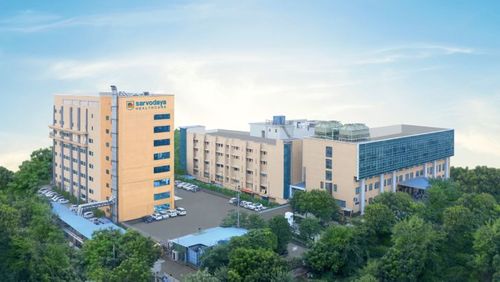Overview
Stereotactic Radiation Therapy is used to treat small brain tumours, vascular malformations, and functional disorders with exceptional accuracy. Unlike conventional radiation therapy, SRT delivers multiple precisely focused beams of radiation to destroy tumour cells while preserving surrounding healthy tissues.
At the Sarvodaya Cancer Institute, one of the leading cancer hospital in Delhi NCR, we use the cutting-edge Versa HD 6D Couch LINAC system to perform Stereotactic radiotherapy and SBRT (Stereotactic Body Radiotherapy) radiation treatment (for other parts of the body). This next-generation technology enables faster, safer, and more effective treatments in fewer sessions. Our expert radiation oncologists ensure every patient receives personalised, precision-driven care for optimal results with minimal side effects.
Why Stereotactic Radiosurgery is Required (Diseases/Conditions)
Stereotactic radiosurgery/radiation therapy is recommended for patients with small or hard-to-reach brain tumours, vascular abnormalities, and certain functional disorders where open surgery may carry higher risks. It offers a precise, non-invasive alternative to conventional surgery by using targeted high-dose radiation to eliminate diseased tissue while protecting vital brain structures.
At Sarvodaya Cancer Institute, our specialists perform SRS radiotherapy for conditions such as:
- Benign and malignant brain tumours (e.g., meningioma, acoustic neuroma, pituitary adenoma)
- Metastatic brain lesions (secondary brain cancers)
- Arteriovenous malformations (AVMs) – tangled blood vessels in the brain
- Trigeminal neuralgia – a chronic pain disorder caused by nerve irritation
- Spinal and body tumours treated using stereotactic body radiotherapy (SBRT)
By combining 3D imaging, advanced planning software, and precise radiation delivery, SRS allows effective tumour control, minimal complications, and faster recovery for both adult and paediatric patients.
Procedure
At the Sarvodaya Cancer Institute, Stereotactic Radiosurgery (SRS) is performed using the world-class Versa HD 6D Couch LINAC—a system designed for precise, image-guided radiation treatment for cancer. This technology delivers focused, high-energy beams to the tumour from multiple angles, ensuring optimal accuracy while sparing healthy tissues.
- Pre-Treatment Planning: Before treatment, patients undergo detailed imaging (MRI, CT, or PET-CT) to create a 3D model of the tumour. Our expert radiation oncologists then design a personalised radiation plan to determine the exact dosage and beam path.
- Positioning and Immobilisation: A custom head frame or soft mask is fitted to ensure the patient remains perfectly still during the session, ensuring sub-millimetre precision.
- Radiation Delivery: The system directs multiple high-energy beams to the target area. Each beam delivers a small dose that converges precisely on the tumour, achieving the therapeutic effect while minimising exposure to nearby healthy tissue.
- Treatment Duration: The session typically lasts between 30 and 60 minutes. Most patients do not require hospitalisation and can return home the same day.
- Post-Treatment Monitoring: Patients are observed briefly after treatment for any short-term side effects. Follow-up imaging may be scheduled to assess tumour response and treatment success.
Benefits of Stereotactic Radiosurgery (SRS)
Stereotactic radiosurgery combines the accuracy of modern imaging with the precision of high-energy radiation, making it one of the safest and most effective options for treating small or complex tumours. At the Sarvodaya Cancer Institute, our advanced Versa HD 6D Couch LINAC ensures world-class treatment outcomes and enhanced patient comfort.
- Non-Surgical and Painless: A completely non-invasive procedure that avoids incisions, anaesthesia, and lengthy hospital stays.
- Unmatched Precision: High-definition 3D imaging ensures radiation is delivered only to the targeted tumour, preserving nearby healthy tissues.
- Short Treatment Time: Most patients require only a single or few sessions of SBRT radiation treatment, allowing them to resume normal activities quickly.
- Minimal Side Effects: Lower radiation exposure reduces fatigue, hair loss, or skin irritation, making recovery faster and easier.
- Effective for Hard-to-Reach Tumours: Ideal for treating tumours in the brain, spine, and other delicate areas where surgery is risky.
- Faster Recovery and Improved Quality of Life: Patients benefit from minimal discomfort, quicker healing, and long-lasting tumour control.
With its accuracy, safety, and convenience, SRS radiotherapy has become a preferred alternative to conventional surgery for selected patients.
Post-Treatment Lifestyle Modifications
Recovery after stereotactic body radiotherapy (SBRT) or SRS is typically smooth and requires minimal downtime. However, following a few lifestyle adjustments ensures the best long-term outcomes and comfort after treatment.
- Rest and Recovery: Patients are advised to rest for a day or two after treatment to allow the body to adapt and recover from radiation exposure.
- Manage Mild Side Effects: Some patients may experience temporary fatigue, mild headaches, or scalp tenderness. These usually resolve quickly and can be managed with medication prescribed by the doctor.
- Nutrition and Hydration: Maintain a balanced diet rich in proteins, fruits, and vegetables to help the body heal. Drink plenty of fluids to flush out toxins and support overall recovery.
- Activity Resumption: Most patients can resume light daily activities within 24–48 hours. Avoid strenuous exercise or heavy lifting for a few days unless cleared by your radiation oncologist in Delhi.
- Regular Follow-ups: Attend scheduled follow-up appointments for imaging scans to monitor tumour response and ensure successful radiation treatment for cancer.
- Emotional Support: Post-radiation fatigue or anxiety is common. Counselling and family support can help patients manage emotional well-being during recovery.





